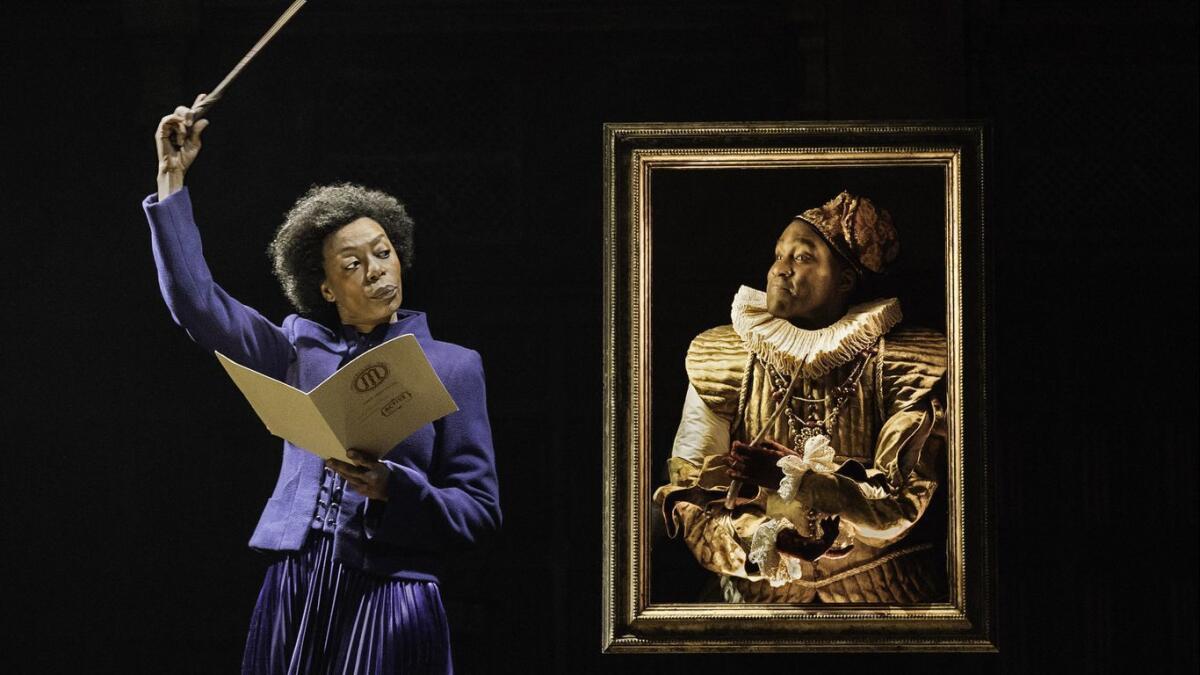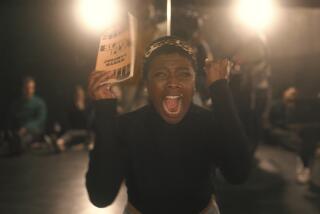Nine black Hermiones, and ‘Harry Potter and the Cursed Child’ still won’t talk race
- Share via
When Yanna McIntosh takes the stage Sunday for opening night at the Curran theater in San Francisco, she becomes the eighth black actress to play Hermione Granger in “Harry Potter and the Cursed Child.”
And, as was just announced, when “Harry Potter und das Verwunschene Kind” takes the stage this spring in Hamburg, Germany, Jillian Anthony will be the ninth.
The two-part theatrical event that won nine Olivier awards and six Tonys is premiering on the West Coast, launching its first non-English language production and coming to Toronto in fall 2020. And yet an important creative decision has for some reason grown into the hippogriff in the room: In “Cursed Child,” Hermione is black.
The play’s producers, Sonia Friedman Productions, declined to comment for this article, noting that the subject of Hermione’s race had been discussed at length when the play opened in London. But that was eight Hermiones ago. When asked to discuss the cultural significance of the casting decision in the era when diversity and inclusion have become priorities in theater, the producers rebuffed The Times’ attempts to speak with the show’s director, actors or anyone else in the production.
Avoiding the discussion, however, doesn’t stop fans from noticing. Some Potterheads’ heads practically exploded when they first learned that black actress Noma Dumezweni had been cast as Hermione in the original London production of “Cursed Child” in 2016. Many were elated to learn that they would finally see themselves reflected in the visage of arguably the smartest, bravest, most honorable heroine in modern literature. A smaller number of fans were incensed. Were they merely sticklers to Potter orthodoxy? Had they perceived the casting as political correctness? Or were they racists? All of the above? An online ruckus ensued.
At the time, J.K. Rowling was widely quoted as saying, “Noma was chosen because she was the best actress for the job.” But after Dumezweni, a two-time Olivier Award-winning actress, left the ensemble, all subsequent Hermiones who have been cast — from London to New York to Melbourne to San Francisco to Hamburg — have been black actors.

Early on, director John Tiffany said he wanted a diverse cast, “but that doesn’t mean I wanted Hermione to be black,” he told Scotland’s Daily Record. Half a dozen or so black Hermiones later, Tiffany was still speaking about diversity but avoiding a deeper discussion. Instead, he spoke in general terms, telling the Guardian in 2018, “I never want to drop what kind of quota of diversity we have got. I think it’s really important that we say: no, we need that number of non-white actors in this cast. But that’s not to say that I can’t do some mixing up.”
Ebony Elizabeth Thomas, author of “The Dark Fantastic: Race and the Imagination From Harry Potter to the Hunger Games,” said “this seems like a way to unofficially address concerns about diversity and inclusion in Harry Potter without officially responding to critiques.”
She speculated that the best way to protect the financial fortunes of the Potter franchise was simply not to discuss the race question publicly.
“The intellectual property is worth $25 billion, therefore it is in the best interest of all involved to keep the widest possible audience happy,” she said.
Hollywood — and Broadway — have a long, egregious track record of casting white actors as nonwhite characters. Filmdom is full of epic fails like Mickey Rooney’s Mr. Yunioshi, Natalie Woods’ Maria, and let us not forget Laurence Olivier in blackface as Othello. Given the history, the recent revelation that Julia Roberts was once considered to play Harriet Tubman hardly registered as a surprise to some.
Has blackwashing become the new whitewashing? Some are happy to see the industry make amends by casting people of color to star as beloved characters in major productions. Critics, however, worry this presto-chango switcheroo is a mere bandage that masks the persistent lack of authentically diverse characters and stories making it to stage and screen.
Currently on Broadway, Glinda in “Wicked” is black. So is Anna in “Frozen” and Hermione in “Cursed Child.” Tiny Tim is black too: The new production of “A Christmas Carol” on Broadway was adapted by Jack Thorne, who wrote “Harry Potter and the Cursed Child.” In “A Christmas Carol,” racial diversity has received less attention than disabled representation: At the insistence of Thorne, Dickens’ disabled character is played by a disabled actor.
New York’s commercial theater culture is changing. Just look at “American Utopia,” “Slave Play” and the work of Tom Hiddleston and Mary-Louise Parker.
On the big screen, Zoë Kravitz will play Catwoman, Lashana Lynch will be the new 007 (a twofer — black and female) and Halle Bailey will play Ariel in the live-action movie version of “The Little Mermaid.”
#NotMyAriel may have been trending for a time, but the backlash to Hermione’s race-bending was far more viral. This, despite Rowling’s support.
“Hermione can be a black woman with my absolute blessing and enthusiasm,” she tweeted in 2015, six months before the play opened. She went on to address the naysayers, tweeting: “Canon: brown eyes, frizzy hair and very clever. White skin was never specified. Rowling loves black Hermione.”
Her tweet received nearly 100,000 “likes,” including emotional outpourings like, “As a black girl who identified with Hermione soooo much growing up, thank you @jk_rowling. Twelve-year-old me is crying happy tears.”
There also were a plethora of “I’m not racist but …” comments. And the #NotMyHermione detectives delved deep into canon (official, original source, in fanspeak) to prove Hermione’s true pigmentation. Rowling’s Twitter feed was flooded with “evidence” from her own old drawings, as well as from photos of Book 3, Chapter 21, Page 293, which states “Hermione’s white face was sticking out from behind a tree.”
Valerie Frankel, who edited the book “Fan Phenomena: Harry Potter,” said she believes Rowling wrote Hermione to be white.
“Certainly, it would have been more inclusive to have all this in the original text, but it’s reasonable to speculate that if Rowling were writing this story today, knowing what a massive franchise it would become, she might make different choices,” Frankel said.
She added that children’s book authors often default to white characters “and then realize it’s kinder to young audiences to mix up the diversity in the next series. ‘Cursed Child’ therefore changed Hermione.”
Sherri Young, executive director of San Francisco’s African-American Shakespeare Company, points out that “anyone could play a clever outcast character with frizzy hair, but when a production chooses to hire a black actor consistently for that particular role, it means there is a message or purpose. So I would like to challenge people who have seen the play to discover if anything is added to the character by making the choice to specifically cast a black actress in the role.”
Lest we forget, Hermione is a mudblood (mixed-race wizard), and Rowling conceived of a world where mudbloods were discriminated against. By the final book, mudbloods were rounded up, detained and interrogated by the government’s Muggle-Born Registration Commission. Compellingly, 19 years later, which is the time-frame of “Cursed Child,” the play’s grown-up Hermione is now the Minister of Magic — kind of like a black president.
Many have noted that the book series can be interpreted as an allegory about racism and white supremacy. “Cursed Child” is officially considered the eighth story in the Harry Potter series. Unofficially, black Hermione has long been a thing on the internet; Potter fan artists choose to remake the characters in their own image, and a black Hermione has been the most ubiquitous race-bent Potter character. Alanna Bennett wrote in Buzzfeed: “I was seeing Hermione’s subtext brought out into text ... painting Hermione as a woman of color [is] an act of reclaiming her allegory at its roots.”
So it’s perplexing to many fans why Rowling — or anyone from the theatrical production — wouldn’t want to say: “Society has evolved, so can the wizarding world.” Instead, the lack of public comment feeds into the narrative of Rowling’s “virtue-signaling” (a conspicuous expression of moral values).
“There is nothing wrong with Hermione being played by a black actress,” wrote Sammy Kumar, an online Potter pundit. “But there is with JKR positing that the Hermione she wrote and envisioned was not white.”
Kumar wrote that the real problem is Rowling’s “blatant attempts to squeeze in diversity she never wrote and then shout it from the rooftops.” Kumar pointed out that Rowling’s black characters are described as black: Angelina Johnson is “a tall black girl with long, braided hair,” and Dean Thomas is a “black boy even taller than Ron.” Characters specifically described as black, Kumar said, are all minor players.
‘I would like to challenge people who have seen the play to discover if anything is added to the character by making the choice to specifically cast a black actress in the role.’
— Sherri Young, executive director of San Francisco’s African-American Shakespeare Company
According to Dylan Marron’s “Every Single Word” video series, only 0.47% of all lines spoken in the eight Harry Potter films are said by people of color.
Even before Hermione was black, cynics were making fun of Rowling’s after-the-fact wokeness and accusing her of PC pandering. The righting of Rowling wrongs has long been a topic of discussion among her fan base. One fan posted online, “J.K Rowling’s the only author I know of that’s managed to fan-fiction her own work.”
There’s much snark lodged against the author, who communicates regularly with her fans on Twitter. After announcing that Dumbledore was gay, a spate of fake woke memes declared that “Snape was a single mother” and “the sorting hat was trans.” Or, more to the point: “J.K. Rowling confirms some characters in her books and movies are gay everywhere except in the books or the movies.”
The did-she-or-didn’t-she debate might have its most nuanced answer from Jenny Jules, the actress currently playing Hermione Granger on Broadway. She told Playbill: “I think in casting Noma Dumezweni, it was color-blind and color-conscious at the same time.” She said the director did choose the best actor, “but in doing that, he said, ‘I’m going to start this journey with this person who happens to be of this racial ethnicity, and I have to think about the future of this character.’” Jules said that by casting subsequent black actresses, “he was starting a revolution.”
“I just know that young women of color are coming into the theater, seeing me as Hermione ... and are seeing me with my afro hairstyle, and it takes their breath away,” Jules added. “And they’re just going, ‘There I am, I’m represented in this story.‘ How amazing is that?”
Jeremy O. Harris, author of “Slave Play,” has taken Broadway by storm this season and hopes to leave it irrevocably changed.
More to Read
The biggest entertainment stories
Get our big stories about Hollywood, film, television, music, arts, culture and more right in your inbox as soon as they publish.
You may occasionally receive promotional content from the Los Angeles Times.










